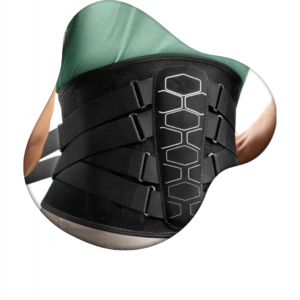In industrial workplaces, tasks involving heavy lifting, repetitive bending, and prolonged standing are common and can lead to chronic back pain, muscle strain, and even severe injuries over time. For small and large businesses alike, protecting workers is essential not only for safety but also for productivity. In Singapore, where workplace safety standards are high, industrial back support belts have become crucial tools to help employees work efficiently and safely.
This guide explores everything you need to know about industrial back support belts, including features, benefits, and statistics to help make an informed decision about integrating back support belts into your workplace.
Table of Contents
ToggleThe Importance of Back Support in Industrial Workplaces
Heavy lifting and repetitive tasks place immense strain on the back, which can lead to musculoskeletal injuries. In Singapore, back injuries and related musculoskeletal issues contribute significantly to workplace injuries, often leading to absenteeism, reduced productivity, and medical expenses.
Statistics on Workplace Musculoskeletal Injuries
The Ministry of Manpower (MOM) in Singapore reports that musculoskeletal injuries make up a substantial portion of workplace injuries.
A study found that back injuries are the most common injury among industrial and warehouse workers, accounting for about 25% of work-related injuries in heavy-duty occupations.
According to global studies, workers using ergonomic back support belts report a 30–50% reduction in musculoskeletal strain, making them essential for industries where manual labor is common.
Back support belts offer a proactive solution to minimize injury risk by promoting good posture and reducing strain. Incorporating these belts not only enhances safety but also boosts morale, showing employees that their well-being is a priority.
Understanding Industrial Back Support Belts
Industrial back support belts are designed to provide lumbar support, reduce strain, and encourage correct posture during heavy lifting or extended standing tasks. They are made from durable materials to withstand demanding conditions and are tailored to suit a wide range of industries.
Key Features of Industrial Back Support Belts
Adjustable Straps
These belts come with adjustable straps to provide a snug fit for various body sizes. This customization ensures that every worker gets optimal support.
Durable, Breathable Materials
Industrial belts are made from materials like neoprene and nylon, which offer durability and breathability. This construction prevents overheating during prolonged use.
Lumbar Pad
Many support belts include an extra lumbar pad to provide enhanced support for the lower back, a critical area for industrial workers.
Non-Slip Inner Layer
To keep the belt secure, non-slip inner layers prevent it from moving or slipping, even during intense physical activity.
Elastic Side Panels
Elastic panels provide added flexibility while maintaining adequate pressure, ensuring the worker’s movements aren’t restricted.
Quick-Release Buckles
Quick-release buckles enable easy fastening and removal, crucial for workers who need to adjust the belt frequently during shifts.
How Industrial Back Support Belts Work
The primary function of a back support belt is to maintain correct posture and reduce strain on the spine during heavy lifting or repetitive tasks. When worn correctly, the belt compresses the abdominal region, effectively distributing weight across the torso, which takes pressure off the lumbar spine. This design prevents workers from overextending or twisting, reducing the risk of injury.
Benefits of Using Back Support Belts in the Workplace
The benefits of industrial back support belts extend beyond individual health to the company’s overall productivity and efficiency.
1. Reduction in Workplace Injuries
By providing support during strenuous activities, these belts help prevent lower back injuries and minimize the occurrence of back pain.
For companies in Singapore and globally, investing in back support belts can reduce workplace injury rates by up to 25%.
2. Improved Employee Productivity
Pain and discomfort can reduce worker productivity. Providing proper support allows employees to complete tasks with minimal strain, leading to improved efficiency.
3. Cost Savings on Medical Expenses and Absenteeism
Fewer injuries mean lower medical costs, compensation claims, and less absenteeism, saving the company both time and money.
4. Increased Employee Morale and Job Satisfaction
Prioritizing employee safety shows workers that the company cares about their well-being, increasing job satisfaction and morale.
Choosing the Right Industrial Back Support Belt
Selecting the right back support belt for industrial applications involves assessing your team’s specific needs and the environment in which they’ll be working.
Factors to Consider
Industry Type
Different industries require different levels of support. For example, belts used in construction may need added durability and weather resistance compared to those used in warehousing.
Size and Fit
Choose adjustable belts to cater to workers of different sizes. An ill-fitting belt may reduce the effectiveness of back support and could even lead to further discomfort.
Weight of Tasks
Heavier tasks require sturdier belts with reinforced support features.
Budget and Quality Balance
While there are many options available, it’s crucial to strike a balance between quality and budget to ensure you’re investing in a reliable product without compromising durability.
Common Questions About Industrial Back Support Belts
How long should workers wear back support belts each day?
Are there any risks associated with back support belts?
How do I know if a back support belt fits correctly?
Are back support belts a replacement for proper lifting techniques?
Back Support Belts as Part of a Broader Workplace Safety Strategy
Integrating back support belts into a safety program should be part of a comprehensive approach to workplace injury prevention, which includes training and education. Combining proper lifting techniques, ergonomics training, and periodic rest breaks with the use of back support belts provides a well-rounded strategy for minimizing injuries.
For businesses in Singapore, investing in workplace injury prevention products like back support belts aligns with safety regulations and reinforces a company’s commitment to employee well-being
If your business involves lifting, repetitive bending, or prolonged standing, industrial back support belts can be a game-changer for safety and productivity. Invest in high-quality back support solutions to protect your workforce and reduce injury-related costs. Visit V-Shield Asia or reach out on WhatsApp at +65 8750 1209 to explore our range of industrial back support belts and workplace protection solutions.


